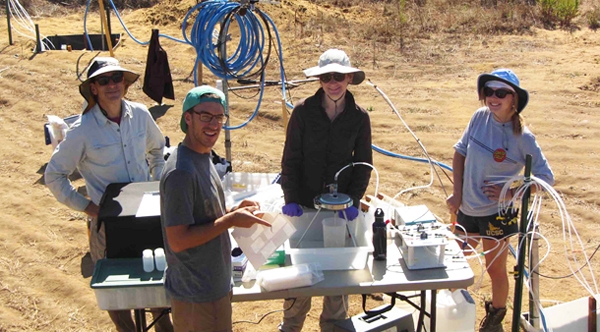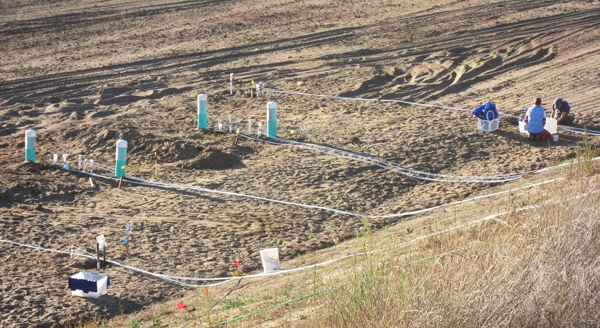How best to capture and store water for many different uses is a big question in California. After years of drought and now the looming possibility of a wet, El Niño-driven winter, safe-keeping any precipitation that does fall is a big priority for water managers. From reservoirs to tunnels to canals, the state's water infrastructure is vast and complicated. However, one approach with a lot of potential that has received little attention so far, at least in California, is managed aquifer recharge (also known as MAR) linked to collection of stormwater runoff.
Professor Andrew Fisher of UC Santa Cruz has been studying MAR for some time. He says it makes use of a variety of methods including infiltration ponds, wells, and in-channel modifications such as berms and inflatable dams to enhance groundwater supplies using water from many possible sources including hillslope and agricultural runoff and high flows in streams and wetlands. MAR has been widely used to augment water supply in Texas and Arizona, at many sites around the world, and in some parts of California. As an added bonus, MAR can help to improve water quality.
As an example, Fisher and colleagues have found that MAR can be used to both increase water supply and reduce nitrate contamination by enhancing denitrification. At one MAR site, the nitrate load reduction during infiltration was 50%, a rate of nitrate removal comparable to that achieved using traditional mitigation strategies like vegetative buffer strips. Interestingly, these studies also showed that the rate of denitrification increased with more rapid infiltration, up to a point. Fisher and his research group are exploring what controls denitrification rates during MAR, and whether MAR systems might help to improve the quality of stormwater runoff in a similar way. This potential to provide joint benefits for both water quantity and quality is something that many find attractive.
Another thing that Fisher notes is particularly valuable about MAR is that it can work in both drought and flood conditions, with a few caveats, of course. During high flow conditions, diversions can be used as a supply for MAR, helping to “take the edge off large events,” says Fisher, turning what was once considered a nuisance into a benefit. During drought, MAR can help to make the most out of short, flashy precipitation events. Fisher and colleagues have found that, even during a drought, “significant recharge benefit can be achieved if systems are designed to optimize runoff collection.” At the same time, droughts can be challenging for MAR projects that are based on runoff in terms of the consistency and quantity of water supply.
Whether in drought or flood conditions, proper design and placement of MAR infrastructure is critical. It follows that one of the biggest questions on the horizon for MAR researchers is where best to place the facilities, something Fisher and his students are working on now, generating regional maps and running models to evaluate where the most MAR benefit can be achieved.
Over the years, his research group has designed, built, and installed instrumentation at several MAR sites around the Central Coast of California. It can be hot, hard work, with upwards of 10 people in the field on any given day. His work is also dependent upon building and maintaining trusting relationships with landowners, agency staff, non-profits, and other stakeholder communities that his group works with as they develop and test projects under real-world conditions. Fisher says what while “each project is unique, we hope to find common elements that will assist in streamlining the design and implementation process.”
Given the uncertainty in California's water outlook, the state needs to adopt creative approaches for enhancing water supplies. Fisher's work suggests that managed aquifer recharge using stormwater runoff has a lot of potential. It will not be enough to resolve California's water shortages, but MAR can play an important role in a portfolio of sustainable water resource solutions.
This research was supported in part through a grant to Principal Investigator Andrew Fisher at the University of California, Santa Cruz from the California Institute for Water Resources in the University of California's Division of Agriculture and Natural Resources.


